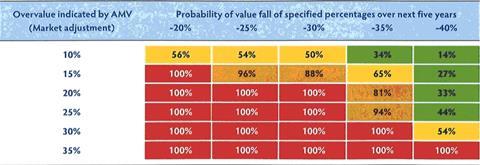UK property lobby groups have backed a metric called adjusted market value (AMV) which they say predicted the 2007-2008 and previous property crashes and which could be adopted by lenders and regulators.

Research published on 3 July by The Property Industry Alliance concludes that, if lenders and regulators had had access to suitable long-term value metrics in the period leading up to the 2007 crash, they could have anticipated the extent to which commercial property was becoming overvalued and seen that a major crash was looming, up to three years before it happened.
Instead, new loans were made at a record rate, mounting to £234 bn (€267 mln) of new lending during 2005-2007, and still at levels in excess of 75% loan to value, according to the De Montfort commercial lending report.
The Bank of England said this morning that the research was ‘a vital step' towards guarding against repeating mistakes and that “all borrowers and lenders should take note.'
The Property Industry Alliance working group which produced the 28-page Long-term Value Methodologies and Real Estate Lending paper, is in talks with MSCI/IPD about publishing a quarterly ‘All Property Adjusted Market Value’ alongside MSCI/IPD’s quarterly capital values index, with the aim of beginning in Q3 2017.
Rupert Clarke, the former CEO of Hermes, who chaired the research group, said: 'The biggest challenge facing property lenders and regulators is how to avoid catastrophic write offs at the end of every major market cycle. This long-term value research is a game changing breakthrough for the proactive management of end of cycle systemic risk. The vital next step is to make sure lenders, regulators and all the lending stakeholders grasp the nettle and resolutely hard wire long-term value techniques into their risk management framework.'
Clarke said more work still needs to be done at sub-sector, portfolio or individual asset level to see how long-term metrics could be applied by individual lenders and regulators and to make sure that lenders 'really, really believe in the metric.'
AMV is not a valuation per se, but a macro-level tool which works by deriving a long-term value trend adjusted for inflation and comparing it to current IPD. It is one of three different long-term value measures analysed in the report in terms of their ability to predict crashes, using historic data.
The others were the mortgage lending value used by German pfandbrief banks, and investment value which the report says also has merit and which Clarke said could be used together with AMV to form a 'hybrid' methodology.
The current AMV level shows the UK market at about 10% above trend. A 10% overvalue suggests a 56% probability of a 20% value fall over the next five years and a 50% chance of a 30% value fall.
At a 15% overvalue, the probability of a 20% fall is 100% and there’s a 65% probability of a 35% crash (see table).
Howver, Clarke said that while there were reasons to be cautious, and that there are 'some very high-profile purchases at very low yields', the whole UK property market 'is not powering ahead..it is not charging towards a cliff.'
The research was sponsored by the Investment Property Forum and CREFC Europe which want as much feedback as possible.
It should be sent to, Peter Cosmetatos, CREFC Europe's chief executive, at pcosmetatos@crefceurope.org by 15 September 2017.










